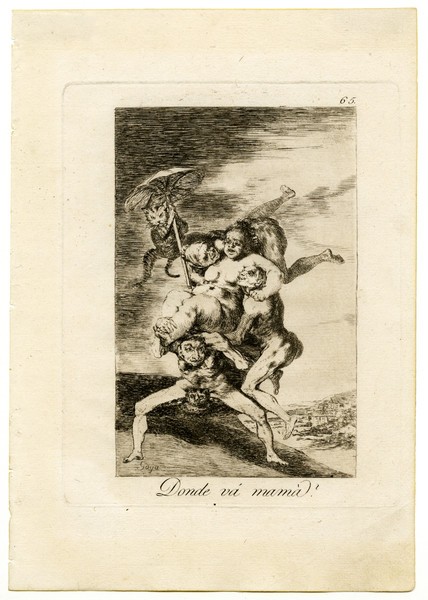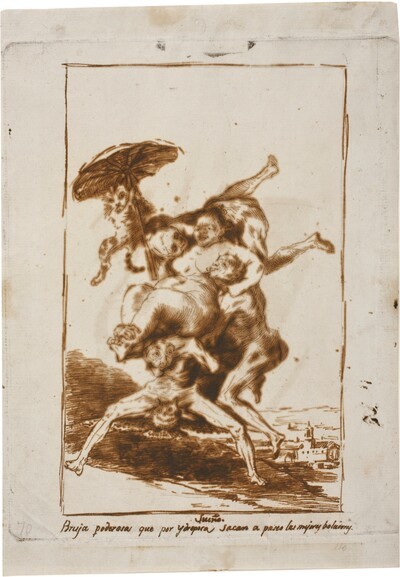- Cronología
- Ca. 1797 - 1799
- Dimensiones
- 210 x 162 mm
- Técnica y soporte
- Aguafuerte, aguatinta y punta seca
- Reconocimiento de la autoría de Goya
- Undisputed work
- Ficha: realización/revisión
- 09 Jan 2011 / 29 May 2024
- Inventario
- 225
Donde vá mamà? (at the bottom)
65. (in the upper right-hand corner)
Goya (signed in the bottom left-hand corner)
See Francisco de Goya y Lucientes, Painter.
There is a proof before the letter with aquatint and drypoint in the National Library of Madrid. Other state proofs are also known in which the title ends in a full stop instead of a question mark and the word "mamà" is unaccented.
A preparatory drawing of this engraving is in the Prado Museum.
A naked, obese witch is leaning on a figure who seems to be making great efforts to support her on her back. The figure has his legs spread and bent and his arms at shoulder height, with which he is holding onto the woman's feet. Next to her are two other figures who are also holding her; the one on the left is mocking her and the one on the right is sucking on one of her breasts. The whole group is supported by an owl with its wings spread in flight, while a cat in the air clings to an open umbrella. In the background, in the lower left corner, Goya has depicted a small village with houses.
The print was executed with a single, very fine-grained aquatint. In addition, Goya has made an insistent use of etching to create the sky, using very close horizontal lines to suggest the clouds in the upper left corner. He also used etching to define the figures in detail, focusing on their anatomies, which he describes in minute detail.
The manuscripts describing the Caprices series are rather sparing with regard to this print. The Prado and Ayala manuscripts both say the same thing: "Madame is hydropic and he sends her for a walk. God willing she will be relieved". The manuscript in the Biblioteca Nacional notes the following: "Lasciviousness and drunkenness in women bring with them infinite disorders and real witchcraft".
It is possible that this print is a dreamlike vision created by Goya in which he did not intend to make a criticism, but simply to offer us a fantastic image in which he has stopped to create a complex and bizarre composition. It is therefore a capriccio in the strict sense of the word, an image obtained from strange associations born of the imagination.
The plate is in rather poor condition, with the aquatint very worn (National Chalcography, no. 236).
-
Goya. La década de Los CaprichosMadrid1992organized by Real Academia de Bellas Artes de San Fernando sponsored by Fundación Central Hispano, Madrid, consultant editor Nigel Glendinnig. From October 26th 1992 to January 10th 1993cat. 31
-
Francisco de GoyaMuseo d'Arte ModernaLugano1996exhibition celebrated from September 22nd to November 17th.cat. 65, p.62
-
Ydioma universal: Goya en la Biblioteca NacionalBiblioteca NacionalMadrid1996from September 19th to December 15th 1996cat. 124
-
Francisco Goya. Sein leben im spiegel der graphik. Fuendetodos 1746-1828 Bordeaux. 1746-1996Galerie KornfeldBern1996from November 21st 1996 to January 1997cat. 71
-
Goya e la tradizione italianaFondazione Magnani RoccaMamiano di Traversetolo (Parma)2006consultant editors Fred Licht and Simona Tosini Pizzetti. From September 9th to December 3th 2006cat. 65, p.162
-
Goya. Opera graficaPinacoteca del Castello di San GiorgioLegnano2006exhibition celebrated from December 16th 2006 to April 1st 2007p.41
-
Goya. La imagen de la mujerMuseo Nacional del PradoMadrid2001from October 30th 2001 to February 10th 2002. Exhibitied also at the National Gallery of Art, Washington, March 10th to June 2nd 2002, consultant editor Francisco Calvo Serrallercat. 85
-
Goya et la modernitéPinacothèque de ParisParís2013from October 11st 2013 to March 16th 2014cat. 168
-
2022
-
Goya engravings and lithographs, vol. I y II.OxfordBruno Cassirer1964p.142, cat. 100
-
Vie et ouvre de Francisco de GoyaParísOffice du livre1970p.183, cat. 581
-
Goya, la década de los caprichos: dibujos y aguafuertesMadridReal Academia de Bellas Artes de San Fernando1992pp.50-51, cat. 31
-
Catálogo de las estampas de Goya en la Biblioteca NacionalMadridMinisterio de Educación y Cultura, Biblioteca Nacional1996p.108, cat. 155-156
-
El libro de los caprichos: dos siglos de interpretaciones (1799-1999). Catálogo de los dibujos, pruebas de estado, láminas de cobre y estampas de la primera ediciónMadridMuseo Nacional del Prado1999pp.330-333
-
ParísPinacoteca de París2013p. 233
-
Goya. In the Norton Simon MuseumPasadenaNorton Simon Museum2016pp. 42-75
-
Museo de Bellas Artes de Badajoz y Diputación de Badajoz2022p. 47

